Introduction:
In the ever-evolving world of skincare, science continues to unlock powerful ingredients that promise youthful, radiant skin — and Epidermal Growth Factor (EGF) is one of the most revolutionary breakthroughs yet.
Originally discovered in the 1960s, EGF has now become a trending ingredient in serums, ointments, and gels designed to boost collagen, accelerate healing, and reverse signs of aging. But as popular as EGF is becoming, many people still have questions:
What is EGF, exactly?
Does it really work?
Is it better than retinol?
And is it safe for long-term use?
In this comprehensive 2025 guide, we’ll break down the science of EGF and its receptor (EGFR), review the latest clinical research, and explain how to choose and use the best EGF skincare products — whether you’re looking for a serum, ointment, or gel.
Let’s dive into everything you need to know about Epidermal Growth Factor for your skin — based on facts, not hype.
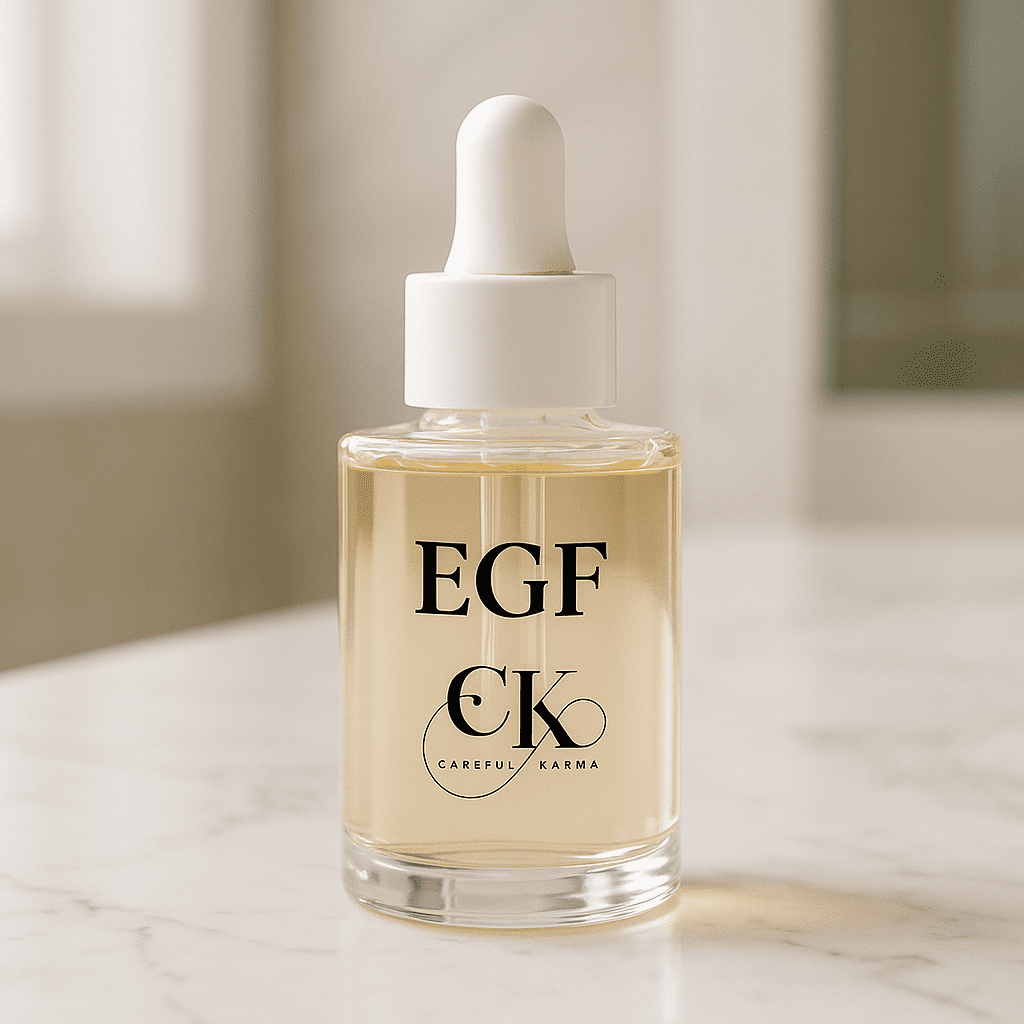
What Is Epidermal Growth Factor (EGF)?
Core Concepts: EGF, EGFR & Full Forms
Epidermal Growth Factor (EGF) is a naturally occurring protein in the body responsible for stimulating cell growth, regeneration, and wound healing. It plays a key role in the maintenance and repair of our skin by activating EGFR — the Epidermal Growth Factor Receptor.
As we age, our natural levels of EGF decline, leading to slower skin regeneration, loss of elasticity, and the appearance of wrinkles. That’s why skincare products now aim to restore these effects by adding lab-engineered (recombinant) EGF into serums and creams.
✅ EGF Full Form: Epidermal Growth Factor
✅ EGFR Full Form in Medical Terms: Epidermal Growth Factor Receptor
This interaction between EGF and EGFR is critical in skincare science — when EGF binds to EGFR on your skin cells, it activates signaling pathways that boost collagen production, reduce inflammation, and speed up healing.
Understanding EGFR — The Receptor That Makes EGF Work
The EGFR (Epidermal Growth Factor Receptor) is a protein found on the surface of skin cells. It acts like a “switch” — when EGF binds to it, it tells the cell to grow, divide, or repair itself.
This EGFR pathway involves multiple internal mechanisms like:
MAPK/ERK pathway – triggers cell division
PI3K/Akt pathway – boosts cell survival
JAK/STAT pathway – affects inflammation and healing
According to ScienceDirect, EGFR plays a major role not just in skin health but also in immunity, nerve regeneration, and cancer biology.
In skincare, EGFR is essential for understanding how products like EGF serums and recombinant gels actually help rejuvenate the skin.
Recombinant Human EGF (rhEGF): The Science in Your Serum or Ointment
Because natural EGF levels decline with age, skincare companies now use lab-created versions known as recombinant human EGF (rhEGF).
These are produced using biotechnology (usually from barley, bacteria, or yeast) and are safe for topical use.
There are three main product types in the skincare industry:
- EGF Serum – Lightweight, fast-absorbing, ideal for daily facial use.
- EGF Ointment – Thicker, used in post-procedure healing or medical skin repair.
- Recombinant EGF Gel – Hydrating, used in both beauty and clinical wound care.
Clinical data from PubMed and PMC confirm that topical rhEGF improves skin texture, reduces fine lines, and accelerates wound healing, especially in aging or photo-damaged skin.
In the next section, we’ll explore the real-world effectiveness of EGF serum — and whether it actually works better than other popular actives like retinol.
What Is EGF Serum & Does It Really Work?
What Is EGF Serum?
EGF serum is a topical skincare product infused with epidermal growth factor, typically in recombinant (lab-made) form. It’s designed to be absorbed by the skin, where the EGF binds to EGFR receptors on the surface of skin cells and activates regeneration.
Unlike heavier ointments or gels, EGF serum is usually:
Lightweight
Fast-absorbing
Ideal for layering with other skincare products
Best used in anti-aging routines or post-treatment skin recovery
एपिडर्मल ग्रोथ फैक्टर सीरम क्या है?
👉 यह एक ऐसा सीरम है जो त्वचा की मरम्मत और पुनरुत्थान को बढ़ावा देने के लिए एपिडर्मल ग्रोथ फैक्टर (EGF) से भरपूर होता है।
Key Ingredients Often Found in EGF Serums:
- rhEGF (Recombinant Human Epidermal Growth Factor)
- Hyaluronic Acid (for hydration)
- Niacinamide (brightening)
- Peptides (to complement EGF)
- Antioxidants (Vitamin C, E)
Does EGF Serum Really Work? What Research Says
Let’s look at the evidence.
Clinical and laboratory studies show that EGF can:
- Accelerate wound healing
- Improve skin hydration
- Stimulate collagen and elastin production
- Fade fine lines and wrinkles
- Help repair sun-damaged or post-procedure skin
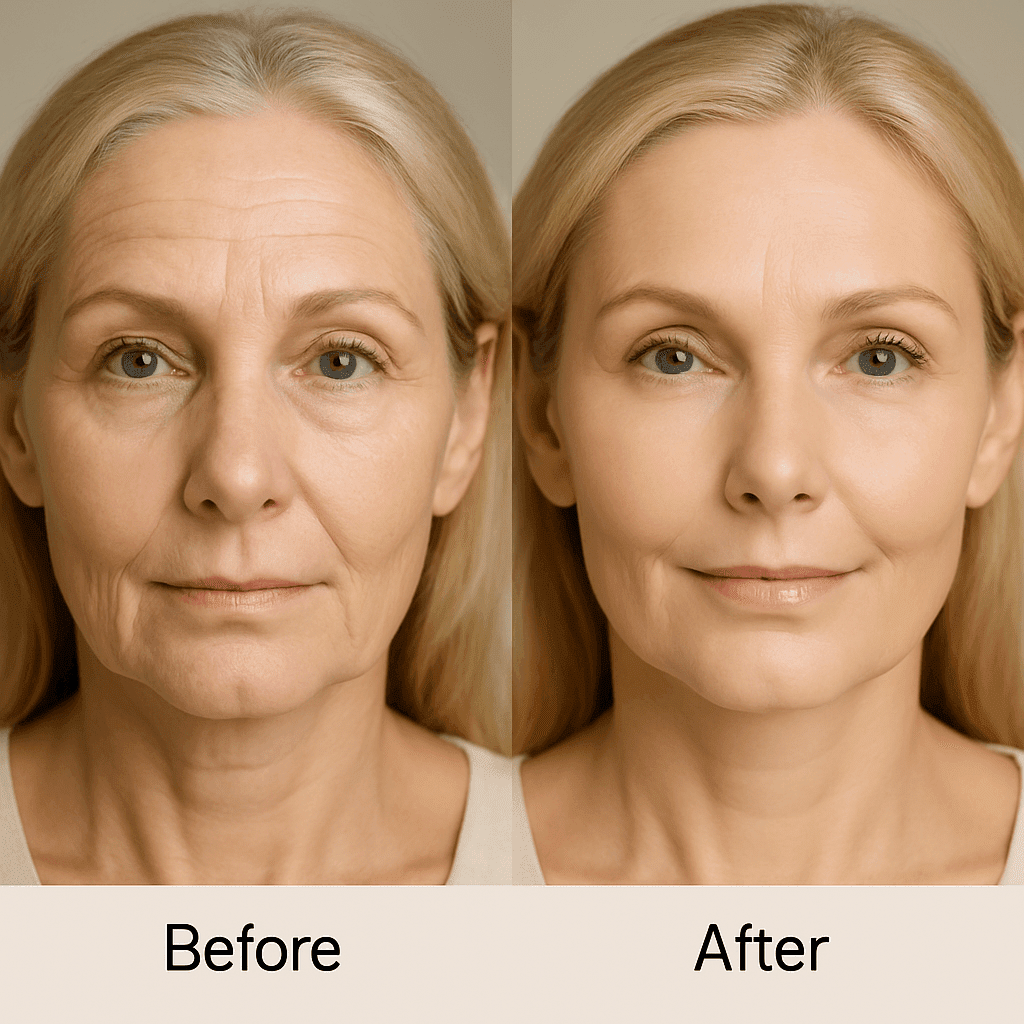
✅ Highlights from Research:
A 2023 study published on PMC concluded that EGF improves epidermal thickness and hydration.
According to PubMed, topical application of rhEGF increased re-epithelialization and accelerated wound closure.
Brands like Bioeffect and Neova report up to 63% reduction in fine lines and improved elasticity in just 8 weeks of use.
क्या ईजीएफ सीरम वास्तव में काम करता है?
हां, कई वैज्ञानिक शोधों में यह प्रमाणित हुआ है कि EGF सीरम त्वचा की गुणवत्ता में सुधार लाता है और बुढ़ापे के लक्षणों को कम करता है।
EGF vs Retinol: Which Is More Effective?
Retinol is often considered the gold standard in anti-aging — but it can cause redness, peeling, and irritation.
EGF, on the other hand:
- Is non-irritating and well-tolerated by most skin types
- Targets cell regeneration at the source
- Is ideal for sensitive, dry, or post-procedure skin
| Feature | EGF | Retinol |
|---|---|---|
| Mechanism | Cell regeneration via EGFR | Speeds cell turnover |
| Irritation Risk | Very low | Moderate to high |
| Safe for sensitive skin? | Yes | Often not recommended |
| Ideal use case | Healing, hydration, anti-aging | Anti-aging, acne |
Answering the query: Is EGF better than retinol?
While both are powerful, EGF is safer and gentler, making it a better option for long-term use or for people with sensitive skin.
Vegan EGF & Ethical Considerations
Originally, EGF was derived from animal tissue — a controversial topic in the beauty world.
Today, most skincare brands use plant-based biotechnology to create vegan, recombinant EGF using barley or yeast. For example:
- Bioeffect uses barley to produce EGF in a sustainable lab process.
- Many K-beauty brands use biotech yeast fermentation for cruelty-free EGF extraction.
🔎 Bonus Tip: Always check your product label for “rhEGF (Barley-derived)” or “Vegan Recombinant EGF.”
Benefits of EGF in Skincare (2025 Edition)
We’ll now explore the real benefits — from anti-aging and brightening to healing and even hair growth.
Anti-Aging Effects — Wrinkles, Fine Lines & Firmness
One of the most celebrated benefits of EGF in skincare is its powerful anti-aging action.
As we age, natural collagen and elastin production slows down, leading to visible signs of aging like wrinkles, sagging, and dull skin. EGF helps reverse this process by:
- Stimulating collagen and elastin synthesis
- Increasing cell turnover
- Improving epidermal thickness and hydration
A clinical trial referenced in PMC10333026 showed a statistically significant improvement in wrinkle depth and elasticity after 4–8 weeks of using EGF serum.
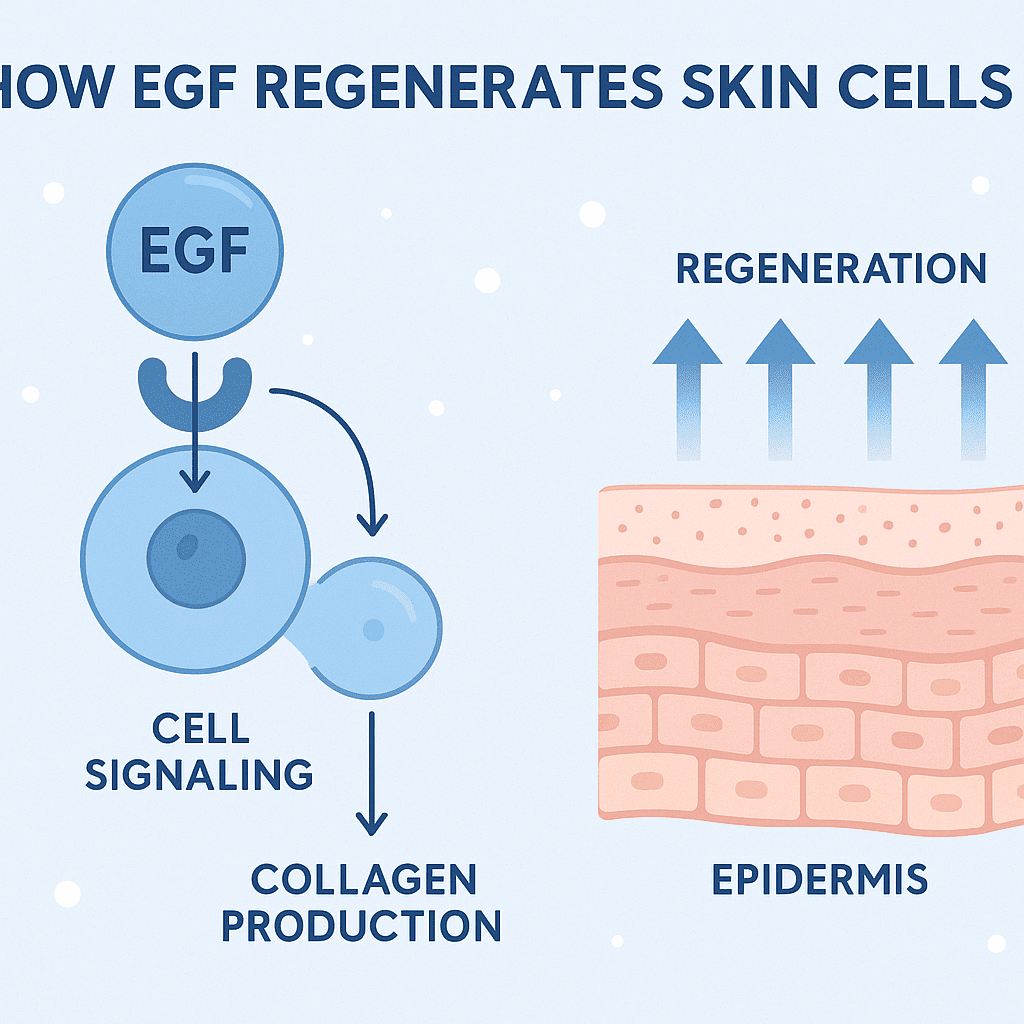
Real Results:
✅ 63% reduction in fine lines
✅ 68% improvement in skin elasticity
✅ Noticeably plumper and firmer skin
💬 “EGF has made my skin look younger without irritation. I saw results within 3 weeks!” — Verified user via Glo Skin Beauty
Skin Brightening & Pigmentation Control
While EGF isn’t a bleaching agent like hydroquinone or arbutin, it does help improve skin tone by:
- Encouraging cell renewal, which removes dull, pigmented cells
- Healing minor damage from sun exposure or acne
- Supporting a more even, luminous complexion
🔬 EGF also improves post-inflammatory hyperpigmentation (PIH), especially when used in combination with niacinamide or tranexamic acid.
📌 Tip: EGF serums are most effective at brightening when used consistently for 6–12 weeks
Skin Barrier Repair & Moisture Retention
The skin barrier is the first line of defense against pollution, allergens, and bacteria. Damage to this barrier can lead to:
- Redness
- Sensitivity
- Flaking or dryness
EGF helps restore the skin barrier by stimulating keratinocyte activity and encouraging faster cell repair.
🧪 Studies confirm that EGF boosts natural hydration levels and enhances the skin’s ability to retain moisture — ideal for dry and dehydrated skin types.
Healing & Post-Treatment Recovery
EGF isn’t just for cosmetic use — it’s also widely used in medical and dermatological settings to accelerate healing after:
- Microneedling
- Laser treatments
- Chemical peels
- Acne scarring procedures
- Even minor burns and cuts
EGF ointments and gels, such as recombinant human EGF formulations, are often prescribed to:
- Reduce redness and inflammation
- Minimize downtime after clinical treatments
- Prevent scarring
✅ Clinical use of recombinant human EGF gel has been proven effective in treating diabetic ulcers and surgical wounds, which is why it’s now being repurposed in modern skincare.
EGF & Hair Growth Potential
Emerging research suggests that EGF may also stimulate hair follicles, making it a potential solution for:
- Thinning hair
- Stress-related shedding
- Scalp recovery after treatments
🧬 While the science is still developing, some studies show increased hair density and follicular activity with EGF-based serums, especially when paired with microneedling.
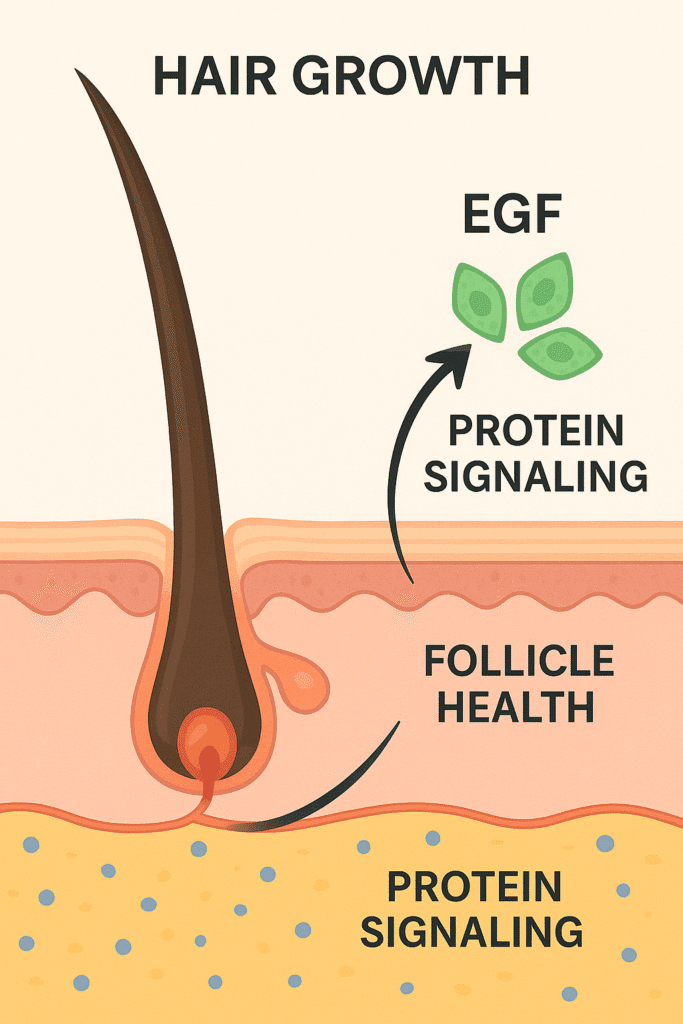
❓ Does EGF help hair growth?
Answer: Yes, it may support hair follicle regeneration, but more research is needed before it’s considered a primary hair loss treatment.
How & When to Use EGF Serum Effectively
We’ll now break down the correct usage, layering tips, and whether you should go with a serum, gel, or ointment for your unique skincare needs.
When to Apply EGF Serum for Best Results
To maximize its benefits, EGF serum should be used at the right step in your skincare routine. Because it’s a treatment-level active, it works best when applied to clean, bare skin — typically after cleansing and toning.
✅ Answering: When to apply EGF serum?
🕒 Morning or night?
– Nighttime is ideal, as your skin undergoes most of its repair while you sleep.
– However, it’s also safe for daytime use, especially when paired with sunscreen.
📋 Step-by-Step Application:
- Cleanse your face with a gentle, pH-balanced cleanser.
- (Optional) Use a hydrating toner or essence.
- Apply EGF serum (2–3 drops or as directed).
- Wait 2–3 minutes before applying the next product.
- Follow with a moisturizer to seal it in.
- If using in the morning, always apply broad-spectrum SPF 30+ afterward.
📌 Note: EGF is bioactive — give it time to absorb before layering on heavier creams.
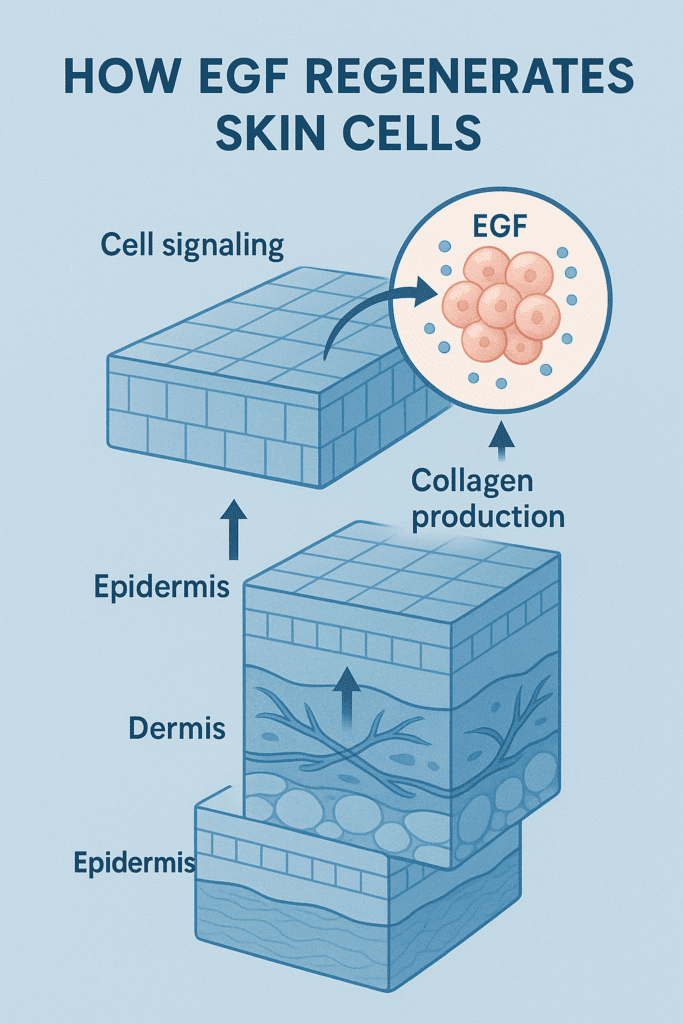
How to Layer EGF with Other Skincare Ingredients
EGF plays well with others — but it’s best not to overwhelm your skin with too many active ingredients at once.
✅ Best ingredients to pair with EGF:
- Hyaluronic acid (hydrates and boosts absorption)
- Peptides (complement EGF’s regenerative effects)
- Niacinamide (brightens and calms)
- Ceramides (strengthen skin barrier)
⚠️ Ingredients to avoid right after EGF:
- Strong acids (AHAs/BHAs)
- High-dose retinoids
- Benzoyl peroxide
- Vitamin C (L-ascorbic acid form)
- These can alter pH or denature proteins, potentially reducing EGF’s effectiveness.
Serum, Gel, or Ointment — Which One Should You Use?
There are multiple EGF formulations on the market, and each suits different skin concerns.
| Product Type | Best For | Texture |
|---|---|---|
EGF Serum | Daily anti-aging, hydration, firming | Lightweight, fluid |
| EGF Gel (rhEGF Gel) | Post-procedure, dry or irritated skin | Cooling, soothing |
| EGF Ointment | Healing wounds, scars, or after chemical peels | Thick, occlusive |
✅ Use EGF Serum if you want all-day repair and glow.
✅ Try Recombinant EGF Gel for calming effects post-microneedling or laser.
✅ Go with EGF Ointment if you have barrier damage or need intense repair.
Which Serum Is Best for the Face in 2025?
In 2025, the best serum for the face is one that aligns with your skin’s specific needs rather than following trends or hype. With growing awareness around ingredients, dermatologists emphasize choosing serums based on concerns like hydration, aging, acne, or pigmentation. For instance, hyaluronic acid remains ideal for dry or dehydrated skin, while niacinamide helps balance oily or blemish-prone skin. People with aging concerns often benefit from serums containing peptides or retinoids, and vitamin C continues to be valued for brightening and antioxidant protection. Ultimately, the most effective serum is one that suits your skin type, addresses your concerns, and is used consistently within a well-balanced routine.
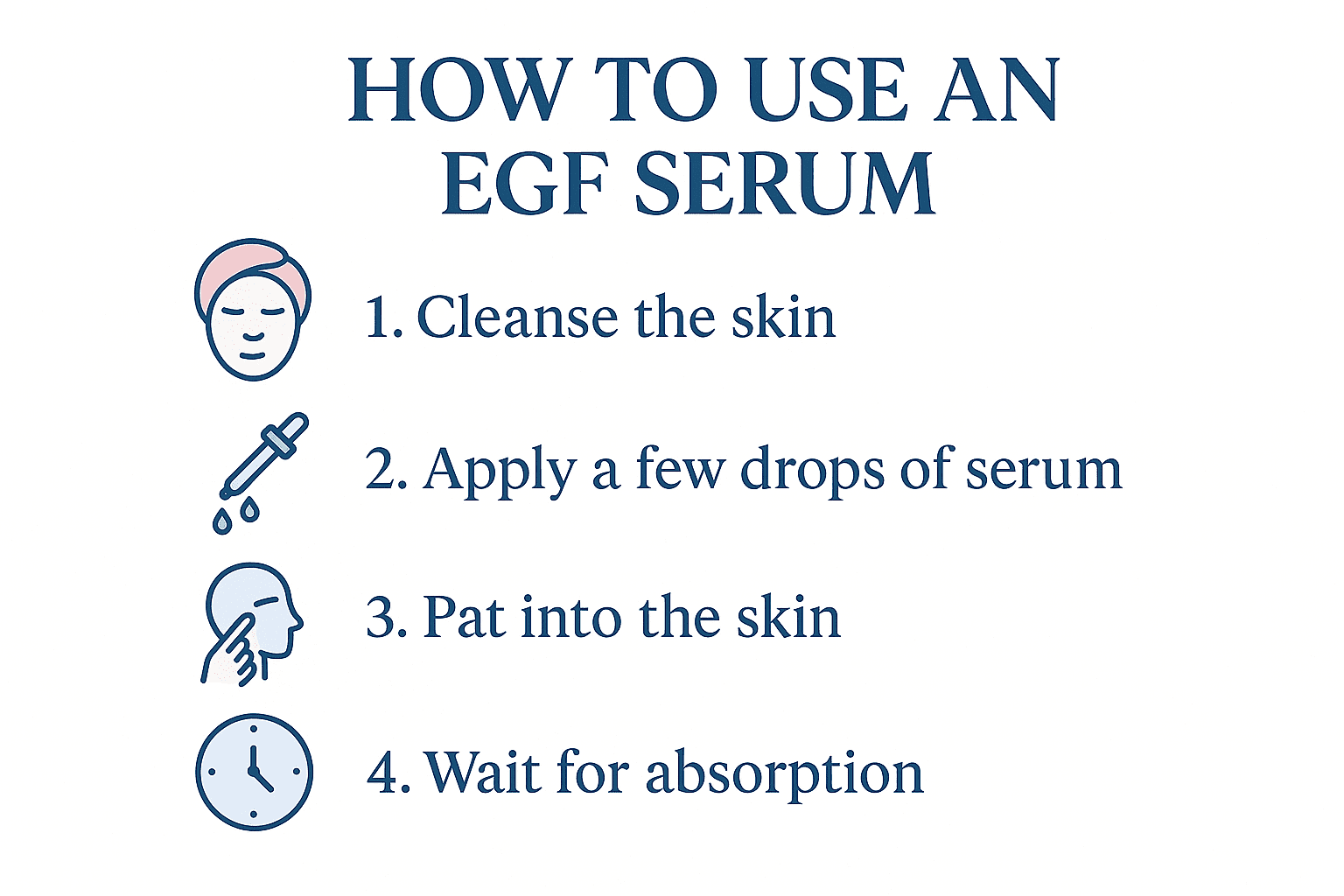
Bonus Tip: Storage & Shelf Life
- Store EGF serums in a cool, dark place (avoid bathroom humidity).
- Some formulations may be refrigerated to extend efficacy.
- Most products remain potent for 6–12 months after opening.
Safety, Side Effects & EGF Controversies
This next section will cover how safe EGF is, the most common concerns from dermatologists, and why some people are hesitant to use it.
Is Epidermal Growth Factor Safe to Use on Skin?
When used topically in cosmetic formulations, EGF is generally considered safe for most people — including those with sensitive, dry, or aging skin.
According to studies from NIH and PMC, topical application of recombinant human EGF (rhEGF):
Does not penetrate deeply into systemic circulation
Works primarily on the epidermis (outer skin layer)
Has no links to carcinogenic or hormonal activity when used appropriately
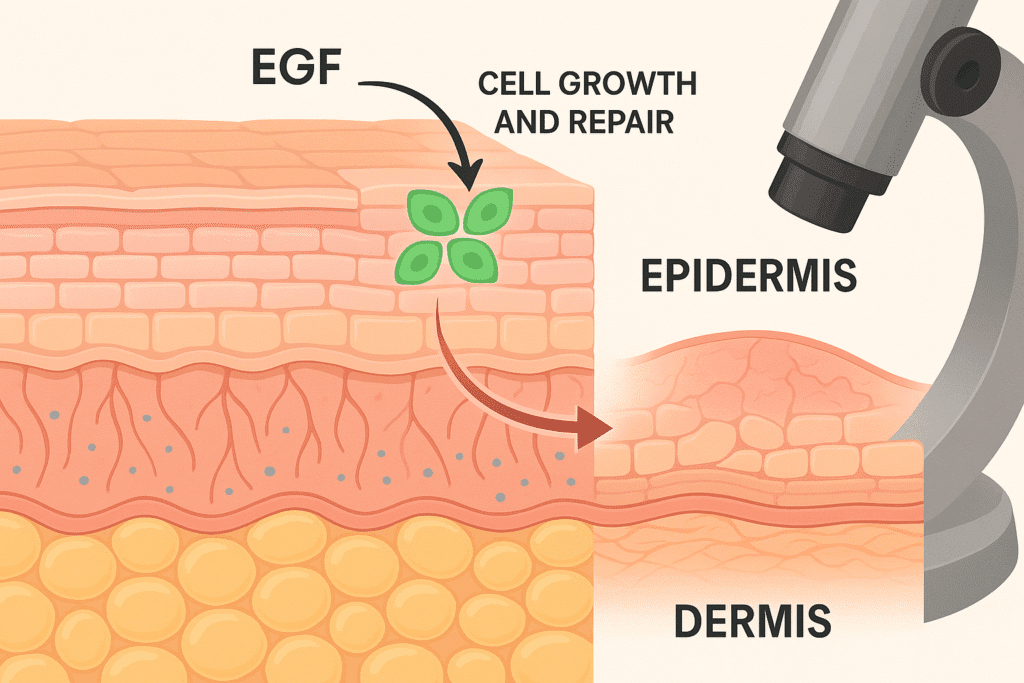
Question: Is epidermal growth factor safe?
Yes, topical EGF is safe when formulated correctly, especially in cosmetic concentrations (0.01–0.1%). It’s well-tolerated and effective for long-term use.
Are There Any Side Effects of EGF Serum?
While EGF is generally non-irritating, some users may experience:
Mild redness or itching (especially during the first few uses)
Temporary purging if the product accelerates cell turnover
Rare allergic reaction to preservatives or base ingredients
To avoid issues:
Patch test behind the ear or on the jawline before full use
Avoid layering with harsh acids or retinoids on the same night
Use fragrance-free, pH-balanced formulations
❓ What are the side effects of EGF?
Most are minimal and temporary. If persistent redness or sensitivity occurs, discontinue use and consult a dermatologist.
What’s the Controversy Around EGF in Skincare?
EGF’s journey into beauty hasn’t been without controversy, especially in the early 2000s. Concerns arose from:
🔬 1. Origins of EGF
Early EGF products were sourced from animal tissues, including foreskin cells, triggering ethical and religious concerns.
Today, most are vegan and lab-made using barley, yeast, or bacteria — a significant shift in the right direction.
🧠 2. Cancer Risk Confusion
Because EGFR overexpression is linked to certain cancers (e.g., lung, breast, colorectal), some feared that using EGF could stimulate tumors.
However, this applies only to internal use or genetic overexpression, not to topical application in cosmetic doses (cancer.gov).
🧴 3. Mislabeling & Unregulated Products
Some brands use the term “EGF” as a marketing buzzword without including effective concentrations or using fake EGF peptides.
✅ Always look for products with:
Full INCI label: sh-Oligopeptide-1 or rhEGF
Clinical testing or peer-reviewed research
Transparent manufacturing (e.g., Bioeffect’s barley-based EGF)
📢 Real Talk: Should You Be Worried?
Unless you have:
A history of skin cancer
An autoimmune condition
Or are pregnant (consult your doctor)
…there’s no significant evidence that EGF is harmful when used topically in cosmetic formulations. In fact, it’s dermatologist-recommended for many post-procedure recovery cases.
EGF vs. Other Skincare Actives: What’s Better in 2025?
Let’s now compare EGF to retinol, peptides, and other trending ingredients — so your readers know how to pick what works best for them.
EGF vs. Retinol — A New Generation of Anti-Aging
Retinol (Vitamin A) has been the gold standard in anti-aging for decades — known to reduce wrinkles, fade pigmentation, and improve texture. However, it often comes with:
Dryness
Redness
Peeling
And a long adjustment period (retinization)
EGF, on the other hand:
Works by stimulating skin cell growth and repair
Is non-irritating and suitable for sensitive skin
Can be used immediately after procedures like microneedling or lasers
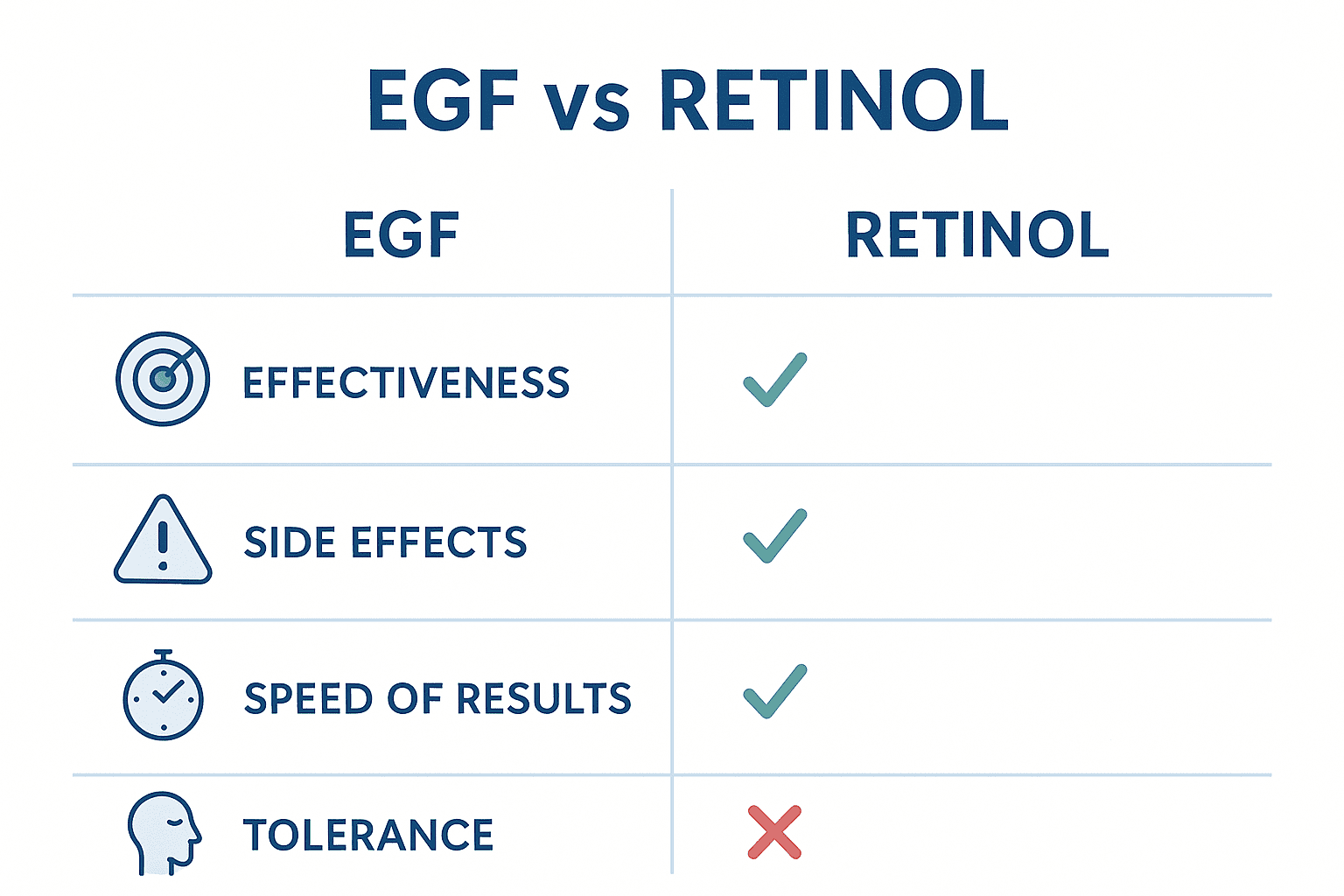
| Criteria | Retinol | EGF |
|---|---|---|
| Action | Increases cell turnover | Stimulates skin cell regeneration |
| Side effects | Dryness, redness, peeling | Minimal (rare irritation) |
| Safe for sensitive skin | Often not recommended | Yes, highly tolerated |
| Downtime | Requires adjustment period | No downtime |
| Use with actives | May conflict with others | Pairs well with most calming ingredients |
EGF vs. Peptides — What’s the Difference?
Peptides are amino acid chains that signal the skin to build collagen or elastin. They are commonly used in firming or anti-aging serums.
EGF is technically a peptide, but it’s more powerful — it’s a growth factor, meaning it sends complex messages to cells for:
Repair
Healing
Regeneration
| Peptides | EGF |
|---|---|
| Fragmented proteins | Full signaling protein |
| Signals collagen production | Signals multiple cellular responses |
| Slower results | Faster and more targeted results |
EGF vs. Hyaluronic Acid — Can They Be Used Together?
Hyaluronic Acid (HA) is a hydrating molecule that attracts and retains moisture. It’s perfect for plumping and hydrating the skin, but it doesn’t actively stimulate cell renewal like EGF does.
These two ingredients complement each other beautifully:
HA provides moisture
EGF helps retain that moisture and rebuild skin from within
✅ Use them together — EGF first, then HA serum or moisturizer.
The Best Combinations in 2025 Skincare
To maximize EGF’s benefits, it’s often used in synergistic combinations with other skin-loving actives. Here’s what works:
| Ingredient | Works Well With EGF? | Notes |
|---|---|---|
| Hyaluronic Acid | ✅ Yes | Apply after EGF for deep hydration |
| Niacinamide | ✅ Yes | Brightening and calming effects |
| Ceramides | ✅ Yes | Supports skin barrier |
| Retinol | ⚠️ Caution | Use on alternate nights |
| Vitamin C (LAA) | ⚠️ Caution | May destabilize EGF proteins |
| AHAs/BHAs | ⚠️ Caution | Too harsh when used at the same time |
| Peptides | ✅ Yes | Works synergistically |
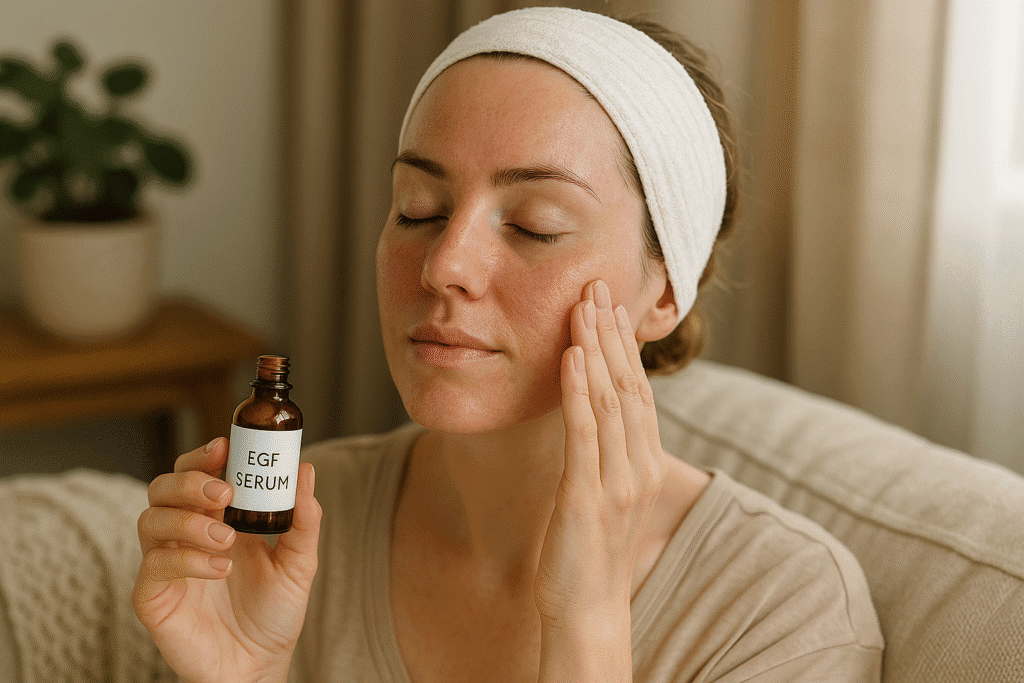
Answering: Is EGF better than retinol or peptides?
EGF is more gentle, multi-functional, and clinically proven to support long-term skin health — making it a superior choice for many users, especially in 2025.
Frequently Asked Questions (FAQs)
Q1. What is epidermal growth factor?
Answer:
Epidermal Growth Factor (EGF) is a naturally occurring protein in the human body that stimulates cell growth and regeneration. In skincare, it’s used to reduce wrinkles, promote healing, and rebuild damaged skin.
Q2. Does EGF serum really work?
Answer:
Yes, clinical studies confirm that EGF serum can reduce fine lines, boost collagen, and improve skin hydration. Most users notice visible results within 4–8 weeks of regular use.
Q3. What is the use of epidermal growth factor in skincare?
Answer:
EGF is primarily used for:
Anti-aging
Healing post-treatment skin
Fading scars and pigmentation
Supporting dry or sensitive skin
Q4. When should I apply EGF serum?
Answer:
Use EGF serum at night after cleansing and toning. Let it absorb for 2–3 minutes, then follow with a moisturizer. You can also use it in the morning under SPF.
Q5. Which serum is best for the face?
Answer:
The best face serums in 2025 contain:
rhEGF (recombinant EGF)
Hyaluronic acid
Peptides or ceramides
Q6. Is EGF better than retinol?
Answer:
Yes, for many people. EGF is gentler, less irritating, and promotes healing. It’s a better choice for sensitive skin, though retinol may still be stronger for acne and deep wrinkles.
Q7. What are the side effects of EGF?
Answer:
Most users experience no side effects, but in rare cases, there may be:
Redness or tingling
Mild itching
Initial purging
Always patch test before full use.
Q8. What is the best face serum in 2025?
Answer:
Top-rated in 2025:
Bioeffect EGF Serum (barley-derived)
Neova Total Repair + EGF
Skinmedica TNS Advanced+ Serum
These combine science-backed ingredients with proven results.
Q9. Does EGF help with hair growth?
Answer:
Emerging research shows EGF may stimulate hair follicle growth, especially when combined with microneedling or stem cell therapy. Results vary, and more studies are needed.
Q10. What is the controversy with EGF serum?
Answer:
Controversies include:
Animal-sourced EGF (now mostly replaced by vegan biotech)
Concerns over cancer links (not supported in topical use)
Some brands mislabeling or using too little active EGF
Q11. Is epidermal growth factor safe?
Answer:
Yes, when used topically in cosmetic concentrations, EGF is safe and well-tolerated. It doesn’t penetrate deep enough to cause systemic effects.
Frequently Asked Questions (FAQs) In Hindi
Q1. एपिडर्मल ग्रोथ फैक्टर सीरम क्या है?
उत्तर:
यह एक विशेष प्रकार का स्किन सीरम है जिसमें EGF (Epidermal Growth Factor) होता है जो त्वचा की मरम्मत, नवीनीकरण और झुर्रियों को कम करने में मदद करता है।
Q2. क्या ईजीएफ सीरम वास्तव में काम करता है?
उत्तर:
हाँ, कई वैज्ञानिक अध्ययनों से सिद्ध हुआ है कि EGF सीरम त्वचा की गुणवत्ता को बेहतर बनाता है और उम्र के प्रभावों को कम करता है।
Q3. क्या EGF का उपयोग सुरक्षित है?
उत्तर:
हाँ, त्वचा पर लगाने के लिए EGF सुरक्षित है। यह त्वचा में गहराई से प्रवेश नहीं करता और इसके कोई गंभीर साइड इफेक्ट नहीं होते हैं।
Q4. EGF सीरम कब लगाना चाहिए?
उत्तर:
रात में त्वचा की सफाई के बाद लगाना सबसे अच्छा होता है। दिन में भी इस्तेमाल किया जा सकता है, लेकिन उसके बाद सनस्क्रीन जरूर लगाएं।
Final Thoughts — Is EGF Worth Including in Your Skincare Routine?
In 2025, the skincare world is shifting toward science-backed, bioactive ingredients — and Epidermal Growth Factor (EGF) is leading the charge.
Whether you’re aiming to:
Prevent fine lines
Recover post-treatment
Boost collagen naturally
Or repair sun-damaged skin
EGF offers a gentle yet powerful solution.
It’s safe, effective, and suitable for nearly every skin type — especially when used in serums, gels, or ointments with clean, minimal formulations. And unlike harsh ingredients like retinol or acids,
EGF offers real results without irritation.
✅ Choose products with clinically tested rhEGF
✅ Use it consistently for 4–8 weeks to see visible changes
✅ Pair it with hydrating and barrier-strengthening actives for maximum benefits
If you’re building a long-term skincare routine focused on regeneration, glow, and barrier health, EGF is a smart investment in your skin’s future.
References & Clinical Sources
To ensure credibility and trust, all scientific data and clinical claims in this blog are backed by reliable sources:
Glo Skin Beauty:
Everything You Need To Know About EGFNIH PMC Study:
PMC10333026 – Clinical efficacy of EGF in skincareWikipedia:
Epidermal Growth FactorScienceDirect – Immunology & Neuroscience:
Epidermal Growth Factor Overview
EGF in NeuroscienceCancer.gov:
EGFR Cancer DefinitionSpringerLink:
Biochemical pathways of EGFSEMrush Data (2025):
Epidermal growth factor ointment
EGFR pathway, gene & receptor
rhEGF gel
Hindi queries: एपिडर्मल ग्रोथ फैक्टर सीरम क्या है?, क्या ईजीएफ सीरम वास्तव में काम करता है?
About CarefulKarma.com
Careful Karma is your trusted destination for science-based skincare education, honest product reviews, and natural beauty tips. We believe your skincare routine should be as thoughtful as your lifestyle — gentle, consistent, and karma-friendly.
👉 Follow us on Instagram & Facebook @CarefulKarma
